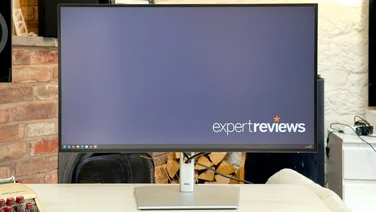To help us provide you with free impartial advice, we may earn a commission if you buy through links on our site. Learn more

When 24in, Full HD screens can be bought for as little as £100, you may be wondering what the Viewsonic XG2401 can possibly offer to justify its £250 price. The answer is a whole slew of gaming-related features. The screen has the lot: a huge 144Hz refresh rate, a claimed 1ms pixel response time to cut down on motion blur, pixel overdrive to reduce blur further, FreeSync for smoother gameplay if you have an AMD graphics card and technology to reduce input lag so actions onscreen directly follow the player’s own.
The monitor feels seriously well made. The plastics in the screen surround and stand feel tough with little flex, and the industrial-feeling stiffness in the monitor’s adjustment mechanisms means there’s no question the panel will stay exactly in the position you want. It certainly feels like a premium product, and the red flashes are just enough to make it look like a gaming screen without crossing into cheesy territory.
There’s plenty of adjustment, too. The panel will tilt towards and away from you, will rotate from landscape to portrait and the panel’s height adjustment means it can sit anywhere from 85mm to 200mm above your desk. Also, the screen’s base sits on a rotating disc, to make it easy to rotate the entire monitor. However, I’d prefer it if the monitor’s stand rotated within the base, as the base itself is huge and will take up half your desk when rotated to a 45-degree angle.
On the back are two HDMI inputs, a DisplayPort connector and a two-port USB3 hub. The screen’s setup menus are reasonably easy to navigate thanks to the five clearly marked buttons under the ViewSonic logo at the front. The only confusing aspect is that the control to go forwards is on the left of the control to go back – having a left button to go back and a right button to go forward would have made more sense.
In the menus you’ll find the option to enable FreeSync, which you should definitely do if you have an AMD graphics card, as I’ll explain below. There’s also the option to enable Advanced Dynamic Contrast Ratio, or DCR. This can supposedly give you contrast ratios of up to 120 million to one, but it’s awful. DCR makes everything look far too stark and colours look wrong. At higher settings, it also ruined on-screen text. DCR is turned on automatically with some of the Game image presets, such as RTS and MOBA, so these should be avoided.
Image quality

You shouldn’t need DCR anyway, as this monitor has an excellent measured contrast ratio of 988:1. Before calibration and set to its default ‘Native’ mode, the screen could display 96% of the sRGB colour gamut, and a 1.86 Delta-E colour accuracy figure is certainly very respectable. In order to achieve its high refresh rate and response times, this screen uses a TN panel. Such panels generally can’t manage such high colour accuracy as IPS models, so these results are impressive. Colour temperature was a little cool, at 6262K versus the ideal 6500K, but after calibration we saw 6625K – a closer match. Calibrating the monitor didn’t improve the Delta-E colour accuracy figure, but increased sRGB coverage to 98%.
As this is a 144Hz monitor, you should go straight into Windows’ advanced display settings and check that the screen is running at the right refresh rate. The fast refresh isn’t just for sky-high frame rates in games. The Windows desktop also benefits, with beautifully smooth window animations.
There’s one significant problem with using this monitor for work, however. As you scroll up and down pages of black text, the text gains a pink tinge. The problem is even more noticeable if you adjust the monitor’s colour balance so there’s more red in the image. The effect is also present if you increase green or blue saturation: black text turns to whichever colour is set highest as you scroll. I found it distracting, if not impossible to live with.
I began to suspect that this was a manifestation of ghosting, where pixels can’t change state quickly enough to keep up with the monitor’s refresh rate. Changing the pixel response time to Ultra Fast did solve the problem, but introduced noticeable halo artefacts around icons when I was dragging around application windows. Knocking the Response Time down a notch to Advanced was a reasonable compromise between the text colour shift and image artefacts, so that would be my recommendation. Setting the Response Time to Ultra Fast also introduced noticeable halos around objects in games, but using the Advanced Response Time setting resulted in no noticeable ghosting or artefacts.
Freesync
As you’d expect, it’s games that this screen really shines. The 144Hz refresh rate makes hugely fast frame rates possible with little of the unsightly tearing that can occur on a 60Hz monitor when it receives more frames from the graphics card than it can display. In the twitch arena shooter Warsow, even with V-Sync disabled I hardly noticed any tearing at frame rates above 200fps, and the game felt much more responsive with V-Sync turned off.
FreeSync explained: how does it stack up against Nvidia’s G-Sync?

The monitor also has built-in FreeSync, which can synchronise the monitor’s refresh rate with that of your (modern AMD) graphics card, so the monitor is never left waiting for frames (causing stutter) or is fed more frames than it can display (causing tearing). The XG2401 has a huge FreeSync range of between 48Hz and 144Hz, so as long as you can keep your game running above 48fps you will benefit.
I tested FreeSync with Dirt Rally. With Ultra detail enabled the game ran at between 50 and 60fps on my test PC, and was perfectly smooth at all times with FreeSync turned on. Once I disabled FreeSync, the difference was obvious as stutter crept in. Of course, if your graphics card can’t stay above 48fps in your favourite games then FreeSync won’t help, but even a mid-range AMD card should manage this in modern titles at 1,920×1,080.
Conclusion
The Viewsonic XG2401 has premium build quality to match its price, and the silky-smooth gaming afforded by FreeSync makes it a joy to use for games. It impressed in our image quality tests, too, but the odd image artefacts I noticed in Windows could be a problem if you need the screen for work as well as games. If you have a FreeSync-compatible AMD graphics card and mainly play games, especially twitchy ones where super-high frame rates make a big difference, this screen could be for you – but think carefully, as another £50 will get you the FreeSync-enabled 4K Iiyama GB2888UHSU.
| Hardware | |
|---|---|
| Screen size | 24in |
| Resolution | 1,920×1,080 |
| Screen technology | TN |
| Claimed contrast ratio | 1,000:1 |
| Claimed brightness | 350cd/m2 |
| Refresh rate | 144Hz |
| Claimed response time | 1ms |
| Response time type | Grey-to-grey |
| Horizontal viewing angle | 170 degrees |
| Vertical viewing angle | 160 degrees |
| Screen depth | 24mm |
| Base (WxD) | 295x225mm |
| Screen elevation | 85-200mm |
| Portrait mode | Yes |
| Internal speaker (power) | Yes (2W) |
| Detachable cables | Yes |
| USB hub | 2-port USB3 |
| Integrated power supply | Yes |
| Video inputs | 2x HDMI, 1x DisplayPort |
| Audio inputs | None (1x 3.5mm audio output) |






